Yingcai Wu
ReSpark: Leveraging Previous Data Reports as References to Generate New Reports with LLMs
Feb 04, 2025Abstract:Creating data reports is time-consuming, as it requires iterative exploration and understanding of data, followed by summarizing the insights. While large language models (LLMs) are powerful tools for data processing and text generation, they often struggle to produce complete data reports that fully meet user expectations. One significant challenge is effectively communicating the entire analysis logic to LLMs. Moreover, determining a comprehensive analysis logic can be mentally taxing for users. To address these challenges, we propose ReSpark, an LLM-based method that leverages existing data reports as references for creating new ones. Given a data table, ReSpark searches for similar-topic reports, parses them into interdependent segments corresponding to analytical objectives, and executes them with new data. It identifies inconsistencies and customizes the objectives, data transformations, and textual descriptions. ReSpark allows users to review real-time outputs, insert new objectives, and modify report content. Its effectiveness was evaluated through comparative and user studies.
Navigating the Risks: A Survey of Security, Privacy, and Ethics Threats in LLM-Based Agents
Nov 14, 2024Abstract:With the continuous development of large language models (LLMs), transformer-based models have made groundbreaking advances in numerous natural language processing (NLP) tasks, leading to the emergence of a series of agents that use LLMs as their control hub. While LLMs have achieved success in various tasks, they face numerous security and privacy threats, which become even more severe in the agent scenarios. To enhance the reliability of LLM-based applications, a range of research has emerged to assess and mitigate these risks from different perspectives. To help researchers gain a comprehensive understanding of various risks, this survey collects and analyzes the different threats faced by these agents. To address the challenges posed by previous taxonomies in handling cross-module and cross-stage threats, we propose a novel taxonomy framework based on the sources and impacts. Additionally, we identify six key features of LLM-based agents, based on which we summarize the current research progress and analyze their limitations. Subsequently, we select four representative agents as case studies to analyze the risks they may face in practical use. Finally, based on the aforementioned analyses, we propose future research directions from the perspectives of data, methodology, and policy, respectively.
CATP: Context-Aware Trajectory Prediction with Competition Symbiosis
Jul 10, 2024Abstract:Contextual information is vital for accurate trajectory prediction. For instance, the intricate flying behavior of migratory birds hinges on their analysis of environmental cues such as wind direction and air pressure. However, the diverse and dynamic nature of contextual information renders it an arduous task for AI models to comprehend its impact on trajectories and consequently predict them accurately. To address this issue, we propose a ``manager-worker'' framework to unleash the full potential of contextual information and construct CATP model, an implementation of the framework for Context-Aware Trajectory Prediction. The framework comprises a manager model, several worker models, and a tailored training mechanism inspired by competition symbiosis in nature. Taking CATP as an example, each worker needs to compete against others for training data and develop an advantage in predicting specific moving patterns. The manager learns the workers' performance in different contexts and selects the best one in the given context to predict trajectories, enabling CATP as a whole to operate in a symbiotic manner. We conducted two comparative experiments and an ablation study to quantitatively evaluate the proposed framework and CATP model. The results showed that CATP could outperform SOTA models, and the framework could be generalized to different context-aware tasks.
ViSTec: Video Modeling for Sports Technique Recognition and Tactical Analysis
Feb 25, 2024Abstract:The immense popularity of racket sports has fueled substantial demand in tactical analysis with broadcast videos. However, existing manual methods require laborious annotation, and recent attempts leveraging video perception models are limited to low-level annotations like ball trajectories, overlooking tactics that necessitate an understanding of stroke techniques. State-of-the-art action segmentation models also struggle with technique recognition due to frequent occlusions and motion-induced blurring in racket sports videos. To address these challenges, We propose ViSTec, a Video-based Sports Technique recognition model inspired by human cognition that synergizes sparse visual data with rich contextual insights. Our approach integrates a graph to explicitly model strategic knowledge in stroke sequences and enhance technique recognition with contextual inductive bias. A two-stage action perception model is jointly trained to align with the contextual knowledge in the graph. Experiments demonstrate that our method outperforms existing models by a significant margin. Case studies with experts from the Chinese national table tennis team validate our model's capacity to automate analysis for technical actions and tactical strategies. More details are available at: https://ViSTec2024.github.io/.
SUB-PLAY: Adversarial Policies against Partially Observed Multi-Agent Reinforcement Learning Systems
Feb 06, 2024Abstract:Recent advances in multi-agent reinforcement learning (MARL) have opened up vast application prospects, including swarm control of drones, collaborative manipulation by robotic arms, and multi-target encirclement. However, potential security threats during the MARL deployment need more attention and thorough investigation. Recent researches reveal that an attacker can rapidly exploit the victim's vulnerabilities and generate adversarial policies, leading to the victim's failure in specific tasks. For example, reducing the winning rate of a superhuman-level Go AI to around 20%. They predominantly focus on two-player competitive environments, assuming attackers possess complete global state observation. In this study, we unveil, for the first time, the capability of attackers to generate adversarial policies even when restricted to partial observations of the victims in multi-agent competitive environments. Specifically, we propose a novel black-box attack (SUB-PLAY), which incorporates the concept of constructing multiple subgames to mitigate the impact of partial observability and suggests the sharing of transitions among subpolicies to improve the exploitative ability of attackers. Extensive evaluations demonstrate the effectiveness of SUB-PLAY under three typical partial observability limitations. Visualization results indicate that adversarial policies induce significantly different activations of the victims' policy networks. Furthermore, we evaluate three potential defenses aimed at exploring ways to mitigate security threats posed by adversarial policies, providing constructive recommendations for deploying MARL in competitive environments.
Real-Time Visual Analysis of High-Volume Social Media Posts
Aug 06, 2021



Abstract:Breaking news and first-hand reports often trend on social media platforms before traditional news outlets cover them. The real-time analysis of posts on such platforms can reveal valuable and timely insights for journalists, politicians, business analysts, and first responders, but the high number and diversity of new posts pose a challenge. In this work, we present an interactive system that enables the visual analysis of streaming social media data on a large scale in real-time. We propose an efficient and explainable dynamic clustering algorithm that powers a continuously updated visualization of the current thematic landscape as well as detailed visual summaries of specific topics of interest. Our parallel clustering strategy provides an adaptive stream with a digestible but diverse selection of recent posts related to relevant topics. We also integrate familiar visual metaphors that are highly interlinked for enabling both explorative and more focused monitoring tasks. Analysts can gradually increase the resolution to dive deeper into particular topics. In contrast to previous work, our system also works with non-geolocated posts and avoids extensive preprocessing such as detecting events. We evaluated our dynamic clustering algorithm and discuss several use cases that show the utility of our system.
EventAnchor: Reducing Human Interactions in Event Annotation of Racket Sports Videos
Jan 14, 2021
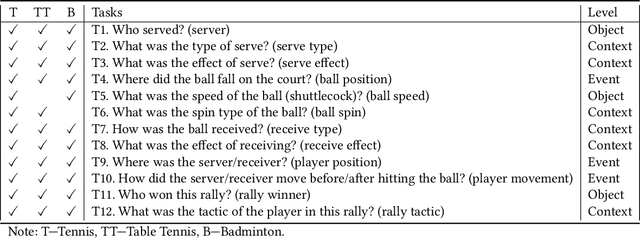


Abstract:The popularity of racket sports (e.g., tennis and table tennis) leads to high demands for data analysis, such as notational analysis, on player performance. While sports videos offer many benefits for such analysis, retrieving accurate information from sports videos could be challenging. In this paper, we propose EventAnchor, a data analysis framework to facilitate interactive annotation of racket sports video with the support of computer vision algorithms. Our approach uses machine learning models in computer vision to help users acquire essential events from videos (e.g., serve, the ball bouncing on the court) and offers users a set of interactive tools for data annotation. An evaluation study on a table tennis annotation system built on this framework shows significant improvement of user performances in simple annotation tasks on objects of interest and complex annotation tasks requiring domain knowledge.
PlotThread: Creating Expressive Storyline Visualizations using Reinforcement Learning
Sep 01, 2020
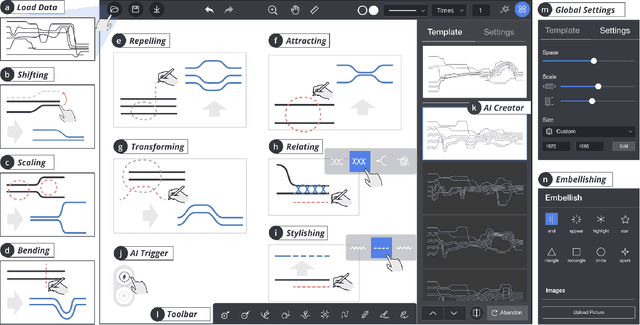
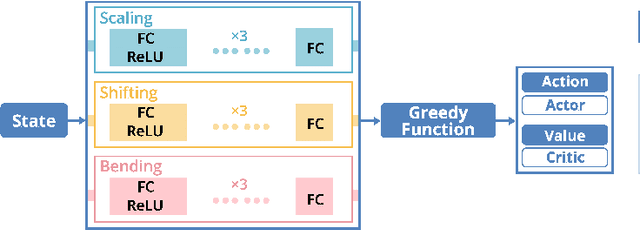
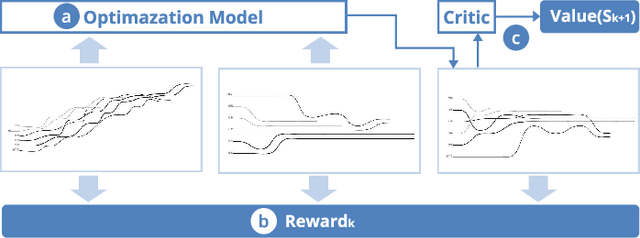
Abstract:Storyline visualizations are an effective means to present the evolution of plots and reveal the scenic interactions among characters. However, the design of storyline visualizations is a difficult task as users need to balance between aesthetic goals and narrative constraints. Despite that the optimization-based methods have been improved significantly in terms of producing aesthetic and legible layouts, the existing (semi-) automatic methods are still limited regarding 1) efficient exploration of the storyline design space and 2) flexible customization of storyline layouts. In this work, we propose a reinforcement learning framework to train an AI agent that assists users in exploring the design space efficiently and generating well-optimized storylines. Based on the framework, we introduce PlotThread, an authoring tool that integrates a set of flexible interactions to support easy customization of storyline visualizations. To seamlessly integrate the AI agent into the authoring process, we employ a mixed-initiative approach where both the agent and designers work on the same canvas to boost the collaborative design of storylines. We evaluate the reinforcement learning model through qualitative and quantitative experiments and demonstrate the usage of PlotThread using a collection of use cases.
VisImages: A Large-scale, High-quality Image Corpus in Visualization Publications
Jul 10, 2020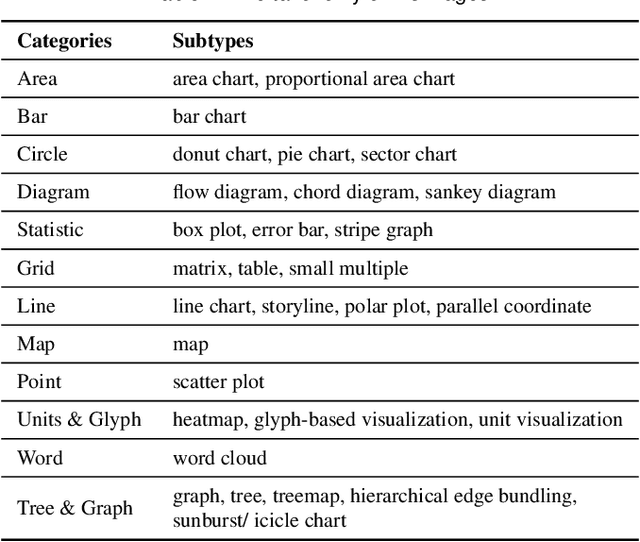
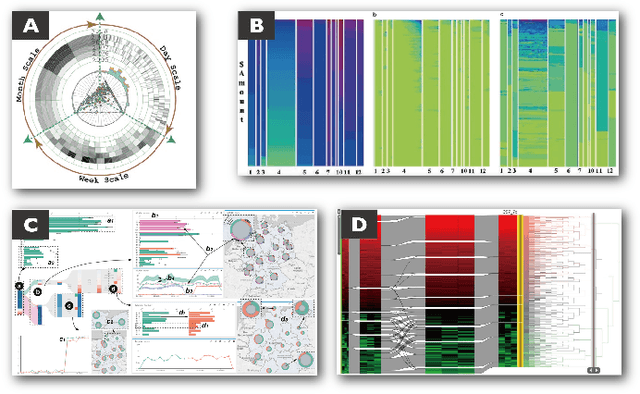


Abstract:Images in visualization publications contain rich information, such as novel visual designs, model details, and experiment results. Constructing such an image corpus can contribute to the community in many aspects, including literature analysis from the perspective of visual representations, empirical studies on visual memorability, and machine learning research for chart detection. This study presents VisImages, a high-quality and large-scale image corpus collected from visualization publications. VisImages contain fruitful and diverse annotations for each image, including captions, types of visual representations, and bounding boxes. First, we algorithmically extract the images associated with captions and manually correct the errors. Second, to categorize visualizations in publications, we extend and iteratively refine the existing taxonomy through a multi-round pilot study. Third, guided by this taxonomy, we invite senior visualization practitioners to annotate visual representations that appear in each image. In this process, we borrow techniques such as "gold standards" and majority voting for quality control. Finally, we recruit the crowd to draw bounding boxes for visual representations in the images. The resulting corpus contains 35,096 annotated visualizations from 12,267 images with 12,057 captions in 1397 papers from VAST and InfoVis. We demonstrate the usefulness of VisImages through the following four use cases: 1) analysis of color usage in VAST and InfoVis papers across years, 2) discussion of the researcher preference on visualization types, 3) spatial distribution analysis of visualizations in visual analytic systems, and 4) training visualization detection models.
Quda: Natural Language Queries for Visual Data Analytics
May 13, 2020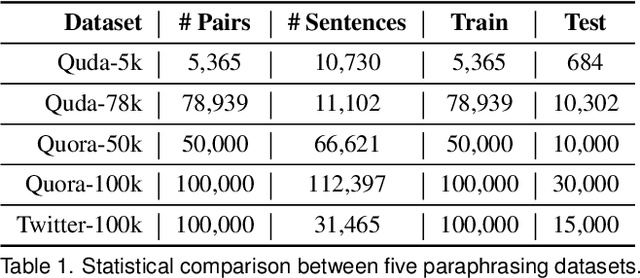
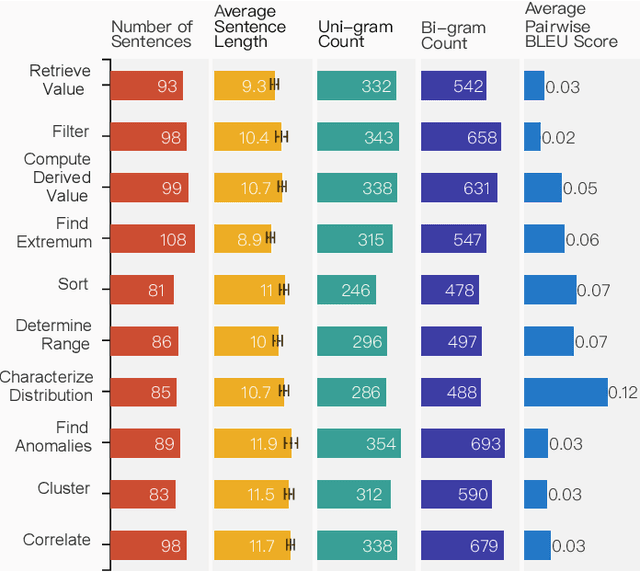
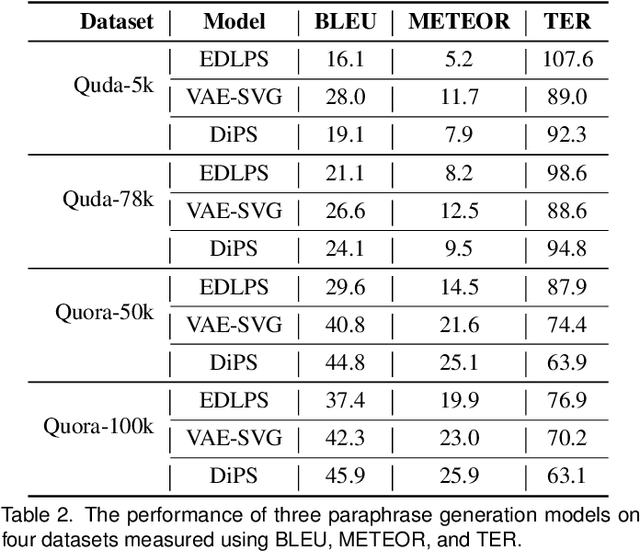
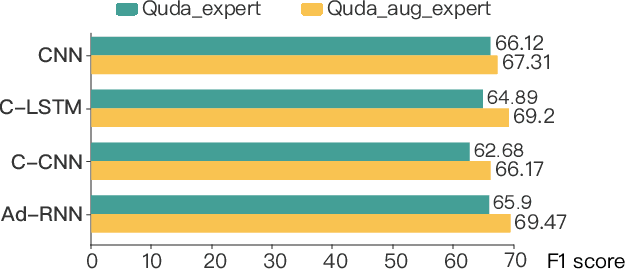
Abstract:Visualization-oriented natural language interfaces (V-NLIs) have been explored and developed in recent years. One challenge faced by V-NLIs is in the formation of effective design decisions that usually requires a deep understanding of user queries. Learning-based approaches have shown potential in V-NLIs and reached state-of-the-art performance in various NLP tasks. However, because of the lack of sufficient training samples that cater to visual data analytics, cutting-edge techniques have rarely been employed to facilitate the development of V-NLIs. We present a new dataset, called Quda, to help V-NLIs understand free-form natural language. Our dataset contains 14;035 diverse user queries annotated with 10 low-level analytic tasks that assist in the deployment of state-of-the-art techniques for parsing complex human language. We achieve this goal by first gathering seed queries with data analysts who are target users of V-NLIs. Then we employ extensive crowd force for paraphrase generation and validation. We demonstrate the usefulness of Quda in building V-NLIs by creating a prototype that makes effective design decisions for free-form user queries. We also show that Quda can be beneficial for a wide range of applications in the visualization community by analyzing the design tasks described in academic publications.
 Add to Chrome
Add to Chrome Add to Firefox
Add to Firefox Add to Edge
Add to Edge